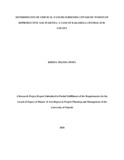| dc.description.abstract | The demand for screening of cervical cancer has remained low over the past decade. In a bid to enhance the public’s knowledge on the conditions screening and at low-resource cost, this research aimed to identify important factors that could encourage the participation of women in Kenya in cervical cancer screening. The objectives of this study include establishing whether education level, the price of cervical cancer screening, health facilities accessibility, income levels, and whether having health insurance would influence uptake of screening for cervical cancer at Kakamega Central sub-county. The study targeted 57,785 women who were within the 18-49 age of reproduction and resided in Kakamega Central Sub-county. A descriptive survey design and questionnaires was administered to 382 women within the reproductive age. A two-stage cluster sampling was employed for random cluster’s selection to be visited. In addition, a random clustering was employed in the selection of listed households for questionnaire administration. STATA 14 was used to assess collected descriptive data collected and the survey results presented via descriptive statistics like percentages, distributions of frequency, and averages. The research findings established that education level (r = 0.229; p < 0.05) monthly earnings (r = 0.39; p = 0.000) and possession of health insurance (r = 0.654; p = 0.000) were all positively linked with uptake of cervical cancer screening. Further, amount of money spent as transport to the health facilities (r = -0.338; p = 0.000), distance from home to health facility (r = -0.218; p = 0.002) and waiting time at the health facility (r = -0.297; p = 0.000) had significant negative association with uptake of cervical cancer screening . However, cost of cervical cancer screening (r = 0.082; p = 0.401) and time it took for one to travel from their homes to the health facility (r = 0.080; p = 0.253) did not have any noteworthy association with uptake of cervical cancer screening. Considering the study findings, the study makes the following recommendations. First, the Kakamega County Government in collaboration with NGOs and the National Government should hold workshops and seminars to create awareness on cervical cancer and encourage women to access health facilities where they can be screened. Secondly, Kakamega County Government in collaboration with NGOs and the National Government should waive cervical cancer screening fees or reduce them so that women from poor economic backgrounds will be able to access the service. Third, the county government should equip all health facilities in the county with cervical cancer screening tools and technology to enable all women who visit those centers to access the near their places of residence. Lastly, the national government should fast track the current campaign that seeks to increase enrollment to NHIF. The county government in partnership with other health stakeholders in the county should come up with their own health insurance to cover those who are from low income households by making them pay affordable annual premiums. This will enable women from such households to be able to access cervical cancer screening services. | en_US |



